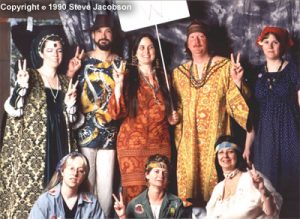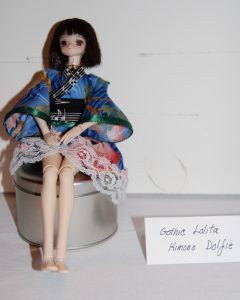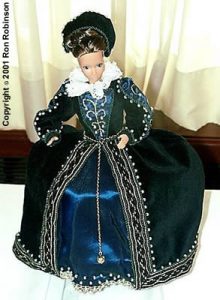CC26-H-29r: Ozmopolitans: the Emerald Citizens
CC26-H-29r: Ozmopolitans: the Emerald Citizens | Division: Master | Category: Hist. Interpretation | Designer(s): Adrian | Maker(s): Kent Elofson‡, Danica Lisiewicz, Nicole Roberts, David Rose, Dawn Rose and Sa Winfield | Presenter(s): Kent Elofson‡, Danica Lisiewicz, Nicole Roberts, David Rose, Dawn Rose and Sa Winfield | Presentation Award(s): Best in Class - Master (Photo ID: Richard Man | Event Date: 2008)
Competition Staff & Rules
Staff:
- Directors: Shelley Monson and Eleanor Farrell
- Master of Ceremonies: Unknown
- Presentation Judges: Unknown
Rules:
Costume-Con 26 Historical Masquerade Rules
Posted: January 30, 2008
Eleanor Farrell and Shelley Monson, Directors
The Costume-Con 26 Historical Masquerade recognizes creativity, scholarship, stage presentation, and workmanship skills in the context of historical clothing. It celebrates the history of costume, including all cultures, periods, and types of dress. “Historical costume” is costume based on clothing that was worn or could have been worn somewhere in the past of this world.
The Historical Masquerade will take place on Sunday, April 27th, 2008.
To enter the CC26 Historical you must be a member of CC26, as must all models you may plan to use. The Historical Masquerade will limit entries to costume based on clothing that was worn or could have been worn through April 25th, 1958 (50 years ago).
Registration:
All entries are encouraged to pre-register. There will be at-the-con registration, but pre-register even if you only think you’ll have a garment completed in time. Deadline for submission by mail: April 15th, 2008. Deadline for registration at the con: 8 p.m. Friday, April 25th, 2008. On-line forms and printable forms will be available soon. Each entrant is asked to mark the appropriate date of the costume on the Registration Form (Time Period). If each costume in a group entry has a different time period, circle all of the appropriate dates. Registration forms can be obtained on the Costume-Con 26 website.
The masquerade will follow the International Costumers’ Guild Guidelines for International-Level Masquerades or Competitions.
Competition Categories:
Entries in all categories are eligible for Best in Class and Best in Show. The Historical Masquerade will have three categories of entry. The cut off date for all categories is April 25th, 1958 (50 years ago).
- Historical Reproduction
- Historical Interpretation
- Ethnic Costume or Dress
Category Definitions:
- Historical Reproduction is a costume that is intended to come as close as possible to recreating an outfit from a particular period of history, from the skin out. This includes costumes copied from a specific artwork or surviving garment, original costumes meant to look as if they were designed and made in a particular period, and everything in between. It is acceptable to use modern substitutes for period materials for reasons of availability, cost, or safety; these substitutions should be noted in documentation. This category is equivalent to Historical Recreation.
- Historical Interpretation covers costumes that are not intended to be “from-the-skin-out” authentic. The goal of the costumer is to create the look of the historical period or “interpret” it, rather than reproduce an original garment. The underpinnings do not have to be authentic, as long as the outfit looks period. It may intentionally and visibly depart from the period on which it is based.
- Ethnic Costume or Dress may be of any culture or period up to 50 years ago.
Ethnic dress is defined as anything that is not mainstream Western fashion; this covers European folk costumes as well as, for example, Miao traditional costume, sarees, sarongs, cheongsam/qipao, kimono, Middle Eastern, etc. It would not include togas, which were mainstream in their time; high Byzantine would be borderline, since it’s almost not Western.
Costumes based on movies, TV shows, or other media may be entered in any category, based on your intent and the date of the original medium. For example, if the original film was made more than 50 years ago, your costume may be entered in Historical Reproduction, since you are reproducing a theatrical garment that existed. If the original source was made less than 50 years ago, but is set in a period more than 50 years ago, you should enter in Historical Interpretation.
Skill Levels:
- Young Fan
- Novice
- Journeyman
- Master
- Exhibition
Skill Level Definitions:
- Young Fan: This level is limited to entrants 13 years of age and younger. Judging will be separate for entries made by a young fan and entries made by an adult that a young fan presents.
- Novice: The Novice level is to encourage beginners. You may not enter at the Novice level if you
- have won two awards at the Novice level in a Costume-Con historical masquerade
- have won at a level higher than Novice in a Costume-Con historical masquerade
- compete at the Master level in science fiction and fantasy masquerades at Costume-Cons or World Science Fiction Conventions (these are the ICG-recognized “international-level competitions”)
- have a costume Laurel in the SCA, or
- are a professional. Professional is defined as someone who earns more than one third of his or her income from fashion or costume, including college or university faculty members.
- Journeyman: The Journeyman level is an intermediate level to recognize further development of costuming skills. You may not enter at the Journeyman level if, at a Costume-Con historical masquerade, you
- have won four awards at the Journeyman level
- have won an award at the Master level
- have won Best in Show, or have a costume Laurel or are a historic costume professional (as defined above).
- Master: This is an open level; anyone may enter at this level. You must enter at this level if you are not eligible to enter as a Young Fan or at the Novice or Journeyman levels (see requirements above).
- Exhibition: This is an open class. Any presenter may enter regardless of skill level. Hall costumes may be displayed in this class, but not in any other. Costumes that have won major awards for presentation or workmanship at previous Costume-Con or WorldCon competitions (excluding Honorable Mention) may appear in this class. Entries in this class are not in competition and are not judged, nor are they eligible for any award.
- A contestant may enter at a level higher than the one for which he or she qualifies. However, an entrant who then wins at that level may not subsequently compete at a lower level. If in doubt over the level at which to compete, consult the Directors.
- A group entry will be assigned to a skill level based on its most experienced member.
Awards:
Our judges will make awards in four areas:
- Documentation
- Workmanship and Detail
- Stage Presentation
- Special CC26 Award for Best Historical Villain
Entries will be judged against what the judges see as the award-winning standard. This means that you will not be competing against anyone else. The judges are not obliged to award Best in Class or Best in Show if, in their opinion, no entry meets the standards for those awards.
Documentation:
Every entry must have some documentation. Documentation must be turned in to the masquerade registration desk by 8:00 p.m. on Friday the 25th of April, 2008. If you are arriving at the con after this deadline, please contact the Directors well in advance.
Basic Documentation:
The basic requirements include:
- Title of costume
- Name and address of the person responsible for the entry (or spokesperson for a group)
- Name(s) of all designer(s), maker(s) and model(s)
- Brief identifying description of the costume’s historical period, geographic origin, social class, and so forth
- Bibliography of sources
The “brief identifying description” should include evidence of the historical basis for the costume. This could be as little as one photocopy of a single picture with an identifying caption or it could be more comprehensive. Assume that the judges are not familiar with the costume(s) or period(s) of your entry. You may wish to begin with a brief statement of your goal.
Advanced Documentation:
In going beyond the minimal requirements, your documentation might include the following:
- Pattern sources
- Photocopies of visual sources, such as artworks, costume drawings, and sketches that you used
- Rationale for design and for choices of fabrics and colors
- Swatches of fabric and trim
- Your own photograph(s) of original historical garments or accessories
- Brief descriptions of any special skills or tools you used, such as shoemaking, weaving, or welding
Good Documentation (Basic or Advanced): Outstanding documentation demonstrates a comprehensive knowledge of the historical source(s) on which a costume is based, with rationales for all elements of the costume, including undergarments, accessories, and minor details, and explanations for deviations from the norm of the period. Excellent documentation also is organized logically and neatly, and presented attractively. Please present all documentation attached together: no loose sheets.
Length of Documentation: Outstanding documentation is brief and concise-long enough but no longer than you need to demonstrate the historical basis of the costume. Text (exclusive of bibliography and captions on illustrations) is limited to no more than five 8-1/2″x11″ typed double-spaced pages in 12-point font per costume. (In a group entry, each costume may have up to five pages of text.) There is no page limit on captioned photographs and illustrations, fabric swatches or other samples, references, or bibliography.
The following will not be accepted as a part of documentation: Original sources, including books and paintings (make copies), slides, computer files, or videos (tape/CD/DVD).
Workmanship and Detail Judging (“Pre-judging”):
This part of the competition is required of all entrants. This is your opportunity to let the judges admire your work up close. Each entry will meet by itself with the panel of judges to show off the costume. Entrants will be expected to show the judges all necessary parts of the costume. If there is an item or element of the costume you want the judges to note especially, be prepared to point it out to them. We recommend that you bring, rather than wear, the costume to the prejudging, so that the judges may handle and examine your work inside and out. However, if you decide to wear the costume to prejudging, be prepared to have the judges look down your cleavage, under your skirt, or at your underwear.
Pre-judging time will be strictly limited, approximately five minutes and certainly no more than ten minutes per person. The schedule will depend on the number of entries received by close of registration. Contestants will have an opportunity to sign up in advance at masquerade registration for appointments with the judges.
Stage Presentation:
Here is your opportunity to complete your illusion before an appreciative audience. Entries with one to six persons will be limited to a maximum of 60 seconds on stage. Entries with seven or more persons will be allowed up to 90 seconds. Please keep in mind that these are maximum, not minimum, lengths of presentation. Feel free to use less time. If you feel that the maximum allowed will not be enough time to show your presentation, the Masquerade Directors will be willing to listen to your argument and possibly allow more time, but that is at their discretion. The Masquerade Directors strongly believe in brief presentations-30 seconds normally should be sufficient to present a one-person entry to the judges and the audience.
Special CC26 Award for Best Historical Villain:
Are you thinking of doing Ancient Rome? How about Caligula or Messalina? Renaissance Hungary? How about Countess Elizabeth Báthory? 15th century Wallachia? How about Vlad the Impaler? Best Historical Villain Award may be given in any division or category.
Safety-related Rules:
- No fire, flame, flashes, firecrackers, or explosions will be permitted-no exceptions!
- Costumes may not be made of or trimmed with messy substances (the “No Peanut Butter Rule”).
- Costumes with electric power requirements must be self-contained-no extension cords will be permitted on stage.
- No live animals (other than guide animals) may be used in the masquerade.
- All special effects and all use of weapons on stage must be approved in advance by the Masquerade Directors.
Other Rules:
- All the general stage presentation rules for Costume-Con 26 masquerades will apply.
- Each contestant may appear only once on stage. You may enter another costume, but it must be on another body.
- There must be some display of skill in creating and executing a design. No flagrant nudity; the masquerade is rated PG-13. Remember, no costume is no costume. No purchased, bespoke, rented or inherited costumes may be shown in the masquerade. Hall costumes may not be shown in competition. They may be displayed out of competition.
- Costumes that have won major awards for presentation or workmanship at previous Costume-Con or WorldCon competitions (excluding Honorable Mention) are ineligible to compete for an award, but may appear out of competition.
- Your costume must be completed before you get to the Green Room. No sewing, gluing, soldering, welding, or other construction work may take place in the Green Room except the final assembly of large costumes and props or unexpected repairs.
- No live microphone is available for entrants’ use; if you plan to use any dialogue, either a recording or a script for the MC is required. Please keep any scripts for the MC to no more than about 100 words. Script must be typewritten; large type is advised (24-point and up).
- We prefer to have music on dedicated CDs, or MP3 files, but will reluctantly accept clean cassette tapes. Label the CD or cassette with your name and the entry title. Bring several copies with you for back-up. If you must use a cassette tape, record your music at the beginning of a standard, blank audiocassette, preferably on both sides, and cue up and label the A side. NO commercial multi-track cassette tapes.
- The default lighting will be stage dark, lights rise on entry, fade to black at exit. Other patterns may be arranged with tech.
- Following a presentation, the entrant(s), roadies, or ninjas must remove all props left on stage in a single pass.
- Entrants and their roadies will be required to attend a tech rehearsal. Further information on schedules, including times for rehearsals and presentations, will come in future Prs.
- The Green Room and back stage area are intended for entrants, roadies, and masquerade staff only. Entrants are asked not to invite other friends or family into the Green Room. Small children must be under the control of a responsible adult at all times (back stage as well as on stage).
- Surprise the audience, but NEVER surprise the Masquerade Directors or Crew!!! If you are planning something unusual or unique, or if you would like to request an exception to any of the rules above, please contact the Masquerade Directors well in advance of the masquerade.
- If you think a personal or business relationship with a judge will make it difficult for the judge to be objective, please contact us. We will consult with the judging panel, and come up with a reasonable course of action.
- The Masquerade Directors have the full authority to eliminate anyone from the competition on the grounds of bad taste, danger to self and/or others, violation of the above rules, or any other reason deemed sufficient. There is no appeal. Offers of cash, chocolate, and/or shiny things will not help.
If you have any questions, please contact the Directors of the Costume-Con 26 Historical Masquerade : Eleanor Farrell / Shelley Monson
[Removed]
The Directors would like to thank all the people who gave us input on these rules, especially the previous Historical Masquerade Directors from whom we cribbed large sections of them. We deeply appreciate their advice, experience, expertise, and willingness to share with us those jewels beyond price.


